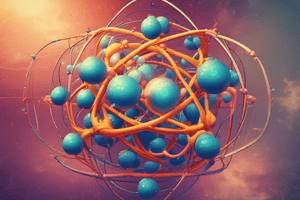Podcast
Questions and Answers
What does the law of conservation of mass state?
What does the law of conservation of mass state?
- Elements can be transformed into one another.
- The mass of the products is greater than the mass of the reactants.
- Mass can be created during a chemical reaction.
- Mass is always conserved and cannot be created or destroyed. (correct)
What is an element defined as, according to chemists in the late 1700s?
What is an element defined as, according to chemists in the late 1700s?
- A substance that can be created from compounds.
- A substance that can exist in different states.
- A substance that cannot be broken down into simpler substances by ordinary chemical means. (correct)
- A substance that can be broken down by ordinary chemical means.
What did chemists begin to emphasize in the 1790s regarding chemical reactions?
What did chemists begin to emphasize in the 1790s regarding chemical reactions?
- The uses of elements in various industries.
- Quantitative analysis of chemical reactions. (correct)
- Qualitative changes in substances.
- The importance of color in reactions.
In the example of the reaction between silver nitrate and sodium chloride, what forms that can be filtered off?
In the example of the reaction between silver nitrate and sodium chloride, what forms that can be filtered off?
If 58.5 grams of sodium chloride and 169.9 grams of silver nitrate are reacted, what is the starting total mass?
If 58.5 grams of sodium chloride and 169.9 grams of silver nitrate are reacted, what is the starting total mass?
What happens to the mass of reactants during a chemical reaction, according to the law of conservation of mass?
What happens to the mass of reactants during a chemical reaction, according to the law of conservation of mass?
What type of substances do elements combine to form?
What type of substances do elements combine to form?
Which of the following statements is NOT true about compounds?
Which of the following statements is NOT true about compounds?
What is the significance of accurate measurements in chemical reactions?
What is the significance of accurate measurements in chemical reactions?
Why might you end up with an extra screw after reassembling a piece of equipment?
Why might you end up with an extra screw after reassembling a piece of equipment?
The law of conservation of mass indicates that mass can be created or destroyed during a chemical reaction.
The law of conservation of mass indicates that mass can be created or destroyed during a chemical reaction.
An element is defined as a substance that can be broken down into simpler substances by ordinary chemical means.
An element is defined as a substance that can be broken down into simpler substances by ordinary chemical means.
Compounds formed from elements have different properties than the elements they are made from.
Compounds formed from elements have different properties than the elements they are made from.
In a chemical reaction, the total mass of the products is always greater than the total mass of the reactants.
In a chemical reaction, the total mass of the products is always greater than the total mass of the reactants.
The process of quantitative analysis in chemistry gained emphasis in the 1790s.
The process of quantitative analysis in chemistry gained emphasis in the 1790s.
When sodium chloride and silver nitrate react, the resulting silver chloride is soluble in water.
When sodium chloride and silver nitrate react, the resulting silver chloride is soluble in water.
When 58.5 grams of sodium chloride and 169.9 grams of silver nitrate are combined, the total starting mass is 228.4 grams.
When 58.5 grams of sodium chloride and 169.9 grams of silver nitrate are combined, the total starting mass is 228.4 grams.
The study of chemical reactions involves mostly qualitative analysis, not quantitative.
The study of chemical reactions involves mostly qualitative analysis, not quantitative.
Elements such as sodium and chlorine can combine chemically to form a more complex compound.
Elements such as sodium and chlorine can combine chemically to form a more complex compound.
The concept of mass conservation applies only to certain types of chemical reactions.
The concept of mass conservation applies only to certain types of chemical reactions.
Study Notes
Law of Conservation of Mass
- Fundamental principle stating total mass of products in a chemical reaction equals the total mass of reactants.
- Mass cannot be created or destroyed; it is always conserved during chemical reactions.
Historical Context
- Late 1700s: Chemists defined an element as a substance that is indivisible by ordinary chemical methods.
- Elements combine to form compounds, which possess distinct chemical and physical properties from the original elements.
Quantitative Analysis
- 1790s saw increased focus on quantitative measurements in chemical reactions.
- Accurate mass measurements of reactants and products were instrumental in formulating essential laws, including conservation of mass.
Example Reaction
- Silver nitrate reacts with sodium chloride in water, producing silver chloride and sodium nitrate.
- Silver chloride precipitates as a solid, while sodium nitrate remains dissolved.
Mass Calculation Example
- Starting masses: 58.5 grams of sodium chloride and 169.9 grams of silver nitrate totals 228.4 grams.
- Final products: 143.4 grams of silver chloride and 85.0 grams of sodium nitrate totals 228.4 grams.
- Demonstrates that mass before and after the reaction remains equal, supporting the law of conservation of mass.
Law of Conservation of Mass
- Fundamental principle stating total mass of products in a chemical reaction equals the total mass of reactants.
- Mass cannot be created or destroyed; it is always conserved during chemical reactions.
Historical Context
- Late 1700s: Chemists defined an element as a substance that is indivisible by ordinary chemical methods.
- Elements combine to form compounds, which possess distinct chemical and physical properties from the original elements.
Quantitative Analysis
- 1790s saw increased focus on quantitative measurements in chemical reactions.
- Accurate mass measurements of reactants and products were instrumental in formulating essential laws, including conservation of mass.
Example Reaction
- Silver nitrate reacts with sodium chloride in water, producing silver chloride and sodium nitrate.
- Silver chloride precipitates as a solid, while sodium nitrate remains dissolved.
Mass Calculation Example
- Starting masses: 58.5 grams of sodium chloride and 169.9 grams of silver nitrate totals 228.4 grams.
- Final products: 143.4 grams of silver chloride and 85.0 grams of sodium nitrate totals 228.4 grams.
- Demonstrates that mass before and after the reaction remains equal, supporting the law of conservation of mass.
Studying That Suits You
Use AI to generate personalized quizzes and flashcards to suit your learning preferences.
Description
Test your understanding of the Law of Conservation of Mass through this engaging quiz. Explore how this fundamental principle applies to everyday situations, like putting equipment back together. Discover common mistakes and learn to keep track of all components during assembly.




